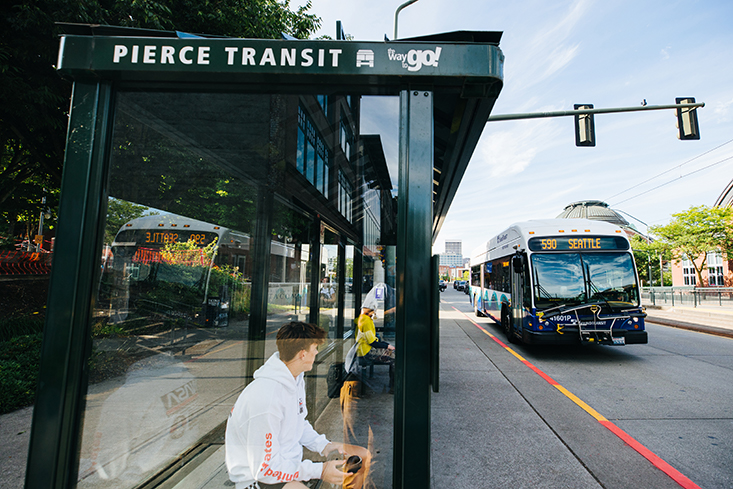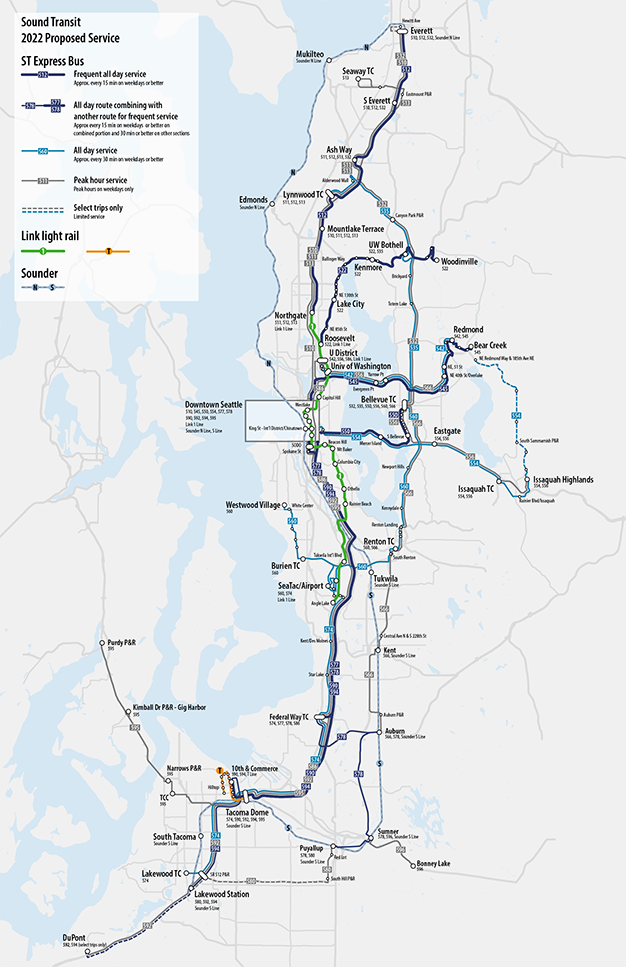Metro and Sound Transit propose service increases in 2022
 Tacoma passengers heading to Seattle (image: Sound Transit)
Tacoma passengers heading to Seattle (image: Sound Transit)With the October 2021 Northgate shakeup of transit service still ahead, agencies are already looking at what changes will be made to service in spring and fall of 2022. King County Metro and Sound Transit both have service increase proposals for 2022, and both take decidedly different approaches.
King County Metro - Restoring old service and monitoring ridershipKing County Metro is taking a conservative approach to restoring service. Rather than making sweeping changes to the network based on assumptions about future ridership, Metro will restore pre-COVID service (with a few exceptions), and see where ridership goes. Starting with the spring 2022 service change, Metro will bring partial or full service to every route that remains suspended after 2021, meaning no routes will be fully suspended at this point. In fall 2022, the tentative plan is to restore full pre-pandemic service. Of course, many details are to be determined. The Metro County Council staff report notes that Metro intends to fine-tune service in fall 2022 and spring 2023, and these changes are anticipated to be within bounds of its administrative authority (which allows Metro to change up to 25% of the routes service hours, move stops up to half a mile, and renumber routes). Since the spring 2023 service change is anticipated to be minor, larger changes to service would likely occur in fall 2023.
Of course, not all pre-pandemic service will be restored. For one, some service was deleted as part of service restructures (the North Eastside Mobility Project in March 2020, the Renton-Kent-Auburn Mobility Project in September 2020, and the upcoming North Link Connections project in October). One other route (route 628) is deleted on its own. And lastly, Metro's full" restoration does not include STBD-funded service, which is planned separately from baseline county-provided service (since it's funded by the city of Seattle and not Metro). This will mean that some busy Seattle routes will have less service than pre-pandemic, and route 47 (which was 100% funded by the STBD) will not be restored at all in 2022 (but may be restored later once STBD revenues pick back up, as it's still suspended rather than deleted).
Sound Transit - Respond to new service patternsSound Transit, on the other hand, is responding immediately to apparent shifts in ridership away from peak-oriented service and toward all-day service. Aside from services increases on South Sounder and Tacoma Link (which will also be extended to Hilltop in 2022), there are no increases in peak-hour service proposed. This means that all ST Express service increases in 2022 are all in midday, evening, and weekend service, and none of the suspended routes as of 2022 (which are ST Express routes 541, 544, 555, and 567) will be restored.
Tacoma Link extension to Hilltop
Tacoma Link, which runs 1.6 miles from Tacoma Dome Station to Theater District Station, will be extended 2.4 miles north, around the Stadium district, and then south to Hilltop. At this time, it will be renamed to Line T to follow the new line naming scheme, and fares will begin being collected (it is currently fare free, with support from local businesses). Upon opening of the extension, Sound Transit is considering increasing service frequencies from every 12 minutes to every 10 during the day and on Saturdays, and from every 24 minutes to every 20 on Sundays and weekday evenings.
SounderSound Transit is renaming Sounder South to the S Line, and Sounder North to the N Line. They will also likely be restoring the remainder of suspended trips on the S Line in 2022, bringing the S Line to pre-pandemic levels. No changes are proposed to the N Line, however, leaving the little-used Sounder line with just two hourly trips in each direction.
ST Express The 2022 ST Express network, with more frequent service corridors
The 2022 ST Express network, with more frequent service corridorsIn 2022, Sound Transit will make major changes to midday and weekend service in multiple corridors. In northeast King County, route 535 is getting Sunday service, and headways on both Saturdays and Sundays will improve to every 30 minutes (currently it runs every 60 minutes on Saturdays, and not at all on Sundays). Route 535 will also see its midday weekday service restored (also going from every 60 minutes to every 30 minutes). Route 560, which currently runs hourly on weekends, is also getting its frequency increased to every 30 minutes on Saturdays and Sundays. This (along with the same change to route 578) marks the end of any all-day service corridors running hourly service during the day, giving all these corridors half-hourly service or better.
Service to Tacoma and Federal Way would be getting a big upgrade. While up to now, off-peak frequency for both of these corridors maxed out at every 30 minutes outside of peak hours, Sound Transit's proposed 2022 service plan would give both corridors service every 15 minutes all day, 7 days per week, with service dropping to half-hourly in the evenings, and then hourly in the late evenings. Route 578 to Auburn, Sumner, and Puyallup is also getting its frequency doubled to every 30 minutes on weekends. To Tacoma, this means adding route 590 trips to/from downtown Tacoma in between route 594 trips (which continue to Lakewood every half-hour off-peak), with both routes combining for 15-minute frequency to/from downtown Tacoma. For Federal Way, this will look like both route 577 and 578 going from hourly to half-hourly, with both routes combining for 15-minute headways from Federal Way. With light rail to Federal Way still three years away (and light rail to Tacoma likely 11 years away, based on how well it's been performing in the realignment proposals), getting off-peak frequent service as early as next year is a big win and will do a lot to build ridership in these fast-growing corridors.
Serivce on route 592 will get slower, with added stops at Tacoma Dome Station and on the SODO busway. This is to introduce a new direct connection between DuPont and Tacoma, and to allow new connections to the newly-extended Link Line T. While potentially helpful to a subset of future riders (or current riders who transfer to connecting service at SR 512 P&R), this will make an already nearly 2-hour journey for DuPont passengers (and a still painful one for Lakewood passengers) even worse. Non-stop service from Lakewood to the middle of downtown Seattle, getting riders through the worst of I-5 through the Tacoma Dome, would end. I certainly hope that if this change ends up happening, that ST times route 592 to connect with Sounder at Lakewood Station, to allow DuPont riders to take advantage of the commuter rail service already available to bypass heavy traffic worsened by perpetual construction.
Route 550 is getting frequent service on Sundays. By slightly decreasing peak service service frequency on weekdays (from every 8-10 minutes to 9-10 minutes), Sound Transit is able to bring Sunday service from every 30 minutes to every 15 minutes. This change goes to show just how expensive weekday peak service is, in part because of congestion requiring more service hours, but also because there are just more weekdays than weekends. So closing a frequent service gap that exists on Sunday only is relatively painless. As a result, route 550 riders no longer have to wait until Link Line 2 opens in 2023 for frequent all-day service.
Lastly, route 574 is getting a longer span of service to help airport commuters. As one of the few suburban routes that get good usage in the middle of the night, it's good that Sound Transit is recognizing the unique needs of this route and making it easier for South Sound commuters to get to their jobs at the airport. Now we just need an overnight Link bus for people coming from the north.
Final thoughtsWith Sound Transit and Metro taking different approaches to service restoration, 2022 will be an interesting year. We will see a mix of old peak service patterns that have served thousands of people for years, and new frequent service corridors to meet emerging needs. Every decision is a gamble on how the future will go, but it will ultimately be up to riders, drivers, and voters to decide where things go from here.